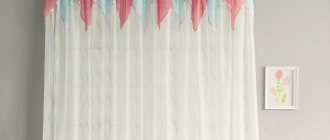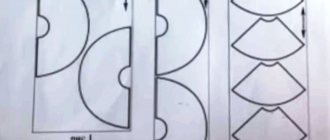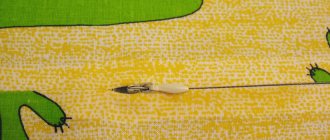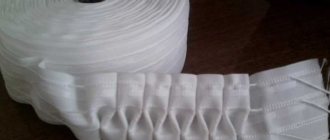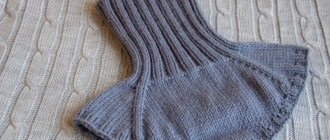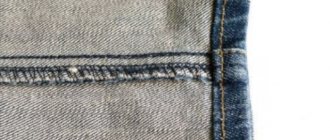Decorating with textiles helps to quickly update the interior of a room and add fresh notes to it. Curtain tape has become widespread for window decoration among designers, sewing craftsmen and housewives. Read further in the article on how to sew curtain tape to curtains.
Not only the beauty of the curtain fabric, but also the way they fall down, forming soft, even folds, decides a lot.
There are many accessories that help you quickly and effortlessly hang curtains on a window, and at the same time give them original and elegant designs.
Curtain tape for curtains and tulle
Curtain tape resembles a ribbon and can be white or colorless. Along its entire length there are parallel ropes, and in the middle there is a dense layer with loops for hanging the curtains to the fixing device.
Curtain tape consists of fabric strips of different widths, along the entire length of which thin ropes or laces are stretched in one or several parallel rows.
The material for curtain tape can be either natural or synthetic fabrics of different densities.
Curtain tape is a special type of soft decorative fittings used to form curtain folds of various sizes and shapes. This is a kind of framework for all variations of assemblies. With the advent of tape, securing curtains has become much easier and more convenient. There is no longer any need to attach metal clips that damage the base or sew on eyelets manually. In total there are approximately 70 varieties of braid.
In the middle of the tape there is a denser layer with loops designed for hanging curtains from a baguette, and ropes are used to create gathers of the desired shape and size.
They differ in the following characteristics.
- Fixation methods. These can be eyelets, loops for hooks, strings, pipes, as well as sticky stickers.
- Fold configuration There can be many options here, which depend on the wishes of the customer or the imagination of the author.
- Dimensions. Braid from 1.5 to 10 cm is considered standardized. 2.5 and 6 cm are more in demand.
- Material. For draping airy organza and veils, fishing line is used, and for thicker, weighty textures, polyester, cotton and paper are used.
After tightening the laces, folds form on the surface of the curtain; they can be given the desired shape.
To remove the curtains, you just need to untie the laces and straighten the tape.
IMPORTANT! Curtain tape is sewn from both natural and artificial fabrics of varying densities. The braid, sewn from rigid materials, holds its shape perfectly.
Types of curtain tapes
Tapes are classified:
- The width of the strip varies between 1.5–10 cm. Narrower ones are sewn to light curtains (tulle, veil, organza), while wider ones are more suitable for curtains made of dense and heavy fabrics.
- According to the degree of transparency, there are 2 types of ribbons - white and translucent. The latter are more suitable for transparent fabrics (tulle, veil and organza), and white ones are sewn to all others.
- By type of folds With a uniform or figured arrangement of cords. A uniform arrangement allows you to form only simple straight folds, while with a figured one you can create more complex ones - cylinders, bows, tails, etc.
- According to the method of fastening, curtain tapes can be sewn or glued. The first ones are attached to the curtain using a hot iron. The disadvantage of adhesive tape is its insufficient load-bearing capacity, that is, such a tape can only withstand light fabrics. Unlike adhesive tape, sew-on braid can withstand fabrics of varying weights, which is why it is more popular.
- By type of drapery Based on this feature, braid is divided into 2 types - for the formation of horizontal or vertical folds. The first is used for sewing traditional curtains and lambrequins, and the second, as a rule, is used in the process of making curtains for high windows (English or French).
There are many types of tapes
How to sew curtain tape to a curtain: step-by-step instructions
To accurately attach the braid and hang the curtains, you need to know how to attach them to the cornice. An incorrect choice of canopy method can harm the author’s idea and spoil the design concept. In addition, this often causes the collapse of the entire mechanism. In construction hypermarkets you can see various samples of cornices. However, the most popular products are made of metal, wood, as well as ceiling and string models.
Curtain tape makes window decoration much easier, especially since you can easily sew it on yourself.
The methods for attaching curtains to them are as follows:
- Rings. The most inexpensive and common fastening method. In addition, they are often included in the main set.
- Drawstrings or pockets located along the top line of the curtain. Designed for fastenings with a circle-shaped cut.
- Clothespins. Suitable for weightless materials only.
- Clips. They are similar to clothespins, but lack the teeth. Designed for products made from weightless textiles. Some subtypes are equipped with locks and may have designer treatments.
- Textile loops are made from the same material as the main product or similar to it.
Tapes made from rigid fabrics retain their shape very well.
Next, using photos and step-by-step instructions, we will look at how to sew ribbon to a curtain. This master class will be useful for both beginners and more experienced craftsmen.
How to hem a curtain and sew curtain tape to it
Initially, examine whether the panel is clearly cut off by the seller of the product. If there is an image on the surface, then there will be no difficulties. In order for the curtain to hang evenly, the edge must be aligned so that it runs perpendicular to the grain thread. You can do a little experiment. Fasten the entire cut to the large wall and assess whether there is any tension on one of the sides up. Next, by testing, determine the position in which the fabric hangs straight.
With the help of curtain tapes, you can create various patterns on the fabric of curtains or tulle using soft draperies.
Follow the following instructions, which tell you how to properly hem curtains and sew on curtain tape:
- Iron the fabric and finish all cut edges. Usually a double hem is made at the bottom. Using this hemming method, it is easy to shorten the product without trimming, since double hemming will remove up to 30 cm of material.
- Before attaching the ribbon, finish the top edge. It is bent to a certain amount and ironed. At the same time, in order to prevent unpleasant surprises, the degree of fineness and texture of the textiles are taken into account.
- Then we make a basting with our hands, having first folded the tape a couple of centimeters and secured it with tailor’s clips.
- We stitch on a machine. The exact number of seams depends on the parameters of the tape: for narrow ones - 2 lines on both parts, for widths up to 12 cm - 3 lines with an auxiliary middle one, and for wide ones - 4 lines.
- After the tape is stitched, we pull the strings and begin to create the intended pattern. It is not recommended to cut long cords: they are made into knots and then hidden.
The value of curtain tape also lies in the fact that there is no need to sew on the loops manually.
The process of tightening the gathers occurs quickly, forming even and desired folds.
IMPORTANT! Most seamstresses make a tiny pocket that performs its special task - it hides excess ropes and their knots from visibility.
How to sew ribbon for hanging curtains on a ceiling cornice
Hanging curtains on super-fashionable ceiling cornices is difficult and time-consuming. They are equipped with special hooks for hanging. For curtains, it is necessary to use mounting tape.
At the same time, fabric of any density drapes beautifully.
To ensure the work is carried out flawlessly, follow the proposed algorithm:
- Check the strength of the fastening of the braid to the fabric.
- Pull out the strings, gather and tie them at one end. This is done in order to reduce the width of the curtains and form clear tails.
- Attach the hooks to the curtain by connecting the loops of a specific shape, sewn into the mounting tape. At the same time, maintain a distance of 10 cm between them.
- Then attach the fasteners to the cornice.
- After completing the work, check the tightness of the fastenings to the cornice.
- Next, you will need to fasten the places where the curtains are dubiously attached, or eliminate the defective components.
Using ribbons, you can change the length of curtains without cutting them by attaching hooks to another row.
The variety of curtain tapes is great, there are approximately 70 types.
If there is an error in installation, the curtain may break in an unexpected situation, for example, in a classroom during a lesson. Therefore, for general safety, you need to make calculations correctly.
How to sew curtain tape onto curtains
The assembly factor in the example under consideration is taken to be minimal, so the curtain tape should be narrow and dense. All you need from the braid is hooks. To sew curtain tape to a curtain, you should carefully select threads that match the color of the blackout fabric. This will make future seams as invisible as possible on the front side of the fabric. Many people make the mistake of purchasing accessories before selecting the fabric. You can go shopping for ribbon when the curtain is already in stock. It is important to make sure that the length of the ribbon will be sufficient, taking into account all the folds and nuances of the cut. However, it is better to buy the tape with a reserve.
Tapes can be transparent or opaque.
The sewing instructions are as follows:
- Start by hemming the sides of the curtains.
- Next, take the curtain face up and place the ribbon on it, also facing down. The folded seam allowance should be sewn on the wrong side.
- Place the first seam along the edge of the braid.
- At the end of the stitching, also fold the seam allowance inwards.
- Turn the curtain inside out and bend the braid on the curtain so that there is 0.5 cm from the border of the braid to the fold. The allowance is necessary to hide the hooks behind the curtain.
- Place the second line also at the edge of the braid. The front side should look smooth and neat.
Braid with fastening loops for hooks can have not one, but several rows of loops.
Simple folds are created using ribbons with two rows of loops, and ribbons with 3 or 4 rows are used to create a decorative top part of the curtain.
Additional Information! It is important to know that small strands are built into the tapes, with the help of which the structure is pulled together to the desired shape. You cannot sew on strands if you plan to use them in the future.
How to sew tulle in the same way?
Good day to all. They ask me to sew such a dress.
It is clear that here tulle is sewn onto the base. But for some reason I can’t understand HOW. Tell me how to do the same, or at least what this technique is called (otherwise I won’t even know what to look for in Google))
So far I only have associations with numbers and letters from napkins)
I will be glad to any advice!
Cut the tulle into pieces - rectangles, squares, ribbons. If there are separate flaps, secure the middle and stitch. If it is tape, then fold and sew. You can apply 2-3 layers of fabric. Frequency and length of flaps - depending on the desired splendor
What if you first sew these pieces onto a thin, neat fabric (matching satin ribbon) and then stitch it to the dress. You can do it in a spiral, or you can do it separately in circles; it will be original if you first agree with the customer on this type of correction in the design of the dress, although it will be a little noticeable.
If it is stripes, then you can sew them with the largest stitch on a machine using a thread of a different color, gather them together, sew them on, and then pull out the first thread. It will be neat.
It seems to me that you need to cut the tulle into strips, gather them onto a thread, that is, make long ruffles, and sew them to the base along curved lines, gradually filling the entire planned area. The stripes must (or can) have different widths.
How to sew braid to tulle
In this option, a thin ribbon is suitable. The first step is to calculate the parameters of the tulle and braid. This is easy to do by multiplying the length of the cornice by the material assembly factor with the addition of 25 cm for deformation and processing.
There are also such types of ribbons as the column, which forms 1 to 2 gathers, and the Austrian ribbon, which forms various patterns and forms folds into “puffs”, “butterflies”, “glasses”.
A tape of 1.5-4 cm is considered narrow. It is necessary when the cornice is covered, when the hooks are covered with a special decorative strip.
When choosing a wide braid, follow the following sequence of actions:
- Carefully process the tulle on all sides except the top. If the material is loose, then additionally overlock it with an overlocker. You can pull back three threads and cut straight.
- Fold the tulle on top with the wrong side to the width of the curtain ribbon and iron.
- Apply tulle braid to the finished fold, stepping back up to 1.5 cm from the fold. The more complex the tails, the greater the distance required. Make sure that the braid does not protrude beyond the border of the canvas.
- Secure the ribbon with pins and baste it to the tulle.
- Sew the tape on the machine. The number of seams should match or be greater than the number of rows on the braid. To avoid creases, the material should be slightly stretched and always stitched in one direction.
- Finish the side edges and remove the basting.
Narrow tape is also used for short curtains made of lightweight fabrics.
If the braid is narrow, the upper cut is folded inside out by 2 cm and then stitched by hand. The curtain tape is secured with 5 mm pins. from the top edge. Then they are sewn in any convenient way. It is important to remember that the loops must be on the outside of the ribbon to secure hooks or rings.
Just as there are many types of curtain tapes, there are also many options for decorative types of folds.
Note! When working with tulle, it is necessary to avoid unnecessary holes from needles and pins, as the material can become deformed. Tulle is an obedient material, and many novice seamstresses begin to “get their teeth” on it.
How to sew a tulle skirt
There are several options for making an airy skirt. There are even the most basic manufacturing options. Additional information! In addition, you will find out what can be created from tulle using such techniques. There is no need to use an overlocker here, since tulle does not require any special processing. The material does not separate into threads at the cut points.
From rectangles
It is easiest to make a skirt from tulle rectangles, since the creation algorithm consists of the following steps:
How to lay out a satin ribbon in waves on a tutu skirt - addition to MK / Tutu skirt with a satin ribbon
- Cut strips from mesh material. The width of any element should not be large - about 15-20 cm. The length of the strip will determine the length of the product, but it must be multiplied by 2.
- Measure a wide elastic band around your waist. Sew the edges together.
- Make small cuts along the elastic around the perimeter. Their number should = the number of prepared tulle strips.
- This is how you should assemble a skirt. When pulling strips of material through the cuts, secure them with knots.
You need to pay attention! This idea is suitable for producing skirts for all life occasions - for a matinee, for a bachelorette party before a wedding, for a carnival.
For a doll
A doll can become a real ballerina if you make a tutu for it. In this case, the sewing procedure is limited to several actions:
- Cut several strips, their length will be 5-6 times the girth of the doll’s body.
- Place all the strips one on top and stitch the pieces on top using a line stitch.
- Pull the thread until the item fits the doll's figure. Secure it with a knot.
Sewing for a doll Hide the ugly seam with a satin ribbon. Leave long ponytails so you can tie the belt with a bow.
Tutu skirt for girls
How to sew a tulle tutu for a girl, which will be an excellent option for going to a dance or a matinee:
- Cut many strips of material that will be 6 times longer than your waist circumference, and the width will resemble a nesting doll.
- Sew each row using a sewing machine, forming folds by overlaying textiles.
- Then the assembly is carried out - all rows are sewn together.
Tutu for girls A rainbow tutu can be created using a similar principle. During the creation process, multi-colored tulle stripes are used.
Tutu skirt for little children
After the birth of the baby, parents in most cases spend the first photo sessions, thinking about all the images. You can create a whole cloud of emotions without much effort when using a pack. You need to pay attention! Apart from a tutu for a newborn, what else is made from tulle?
Bow headband. To make such a costume, you can use the simplest scheme - making a tutu based on the principle of tying rectangles onto an elastic band.
Short tulle tutu skirt with elastic for teenagers
Even a teenage girl is unlikely to refuse an airy tutu skirt. How to sew a similar wardrobe item for a teenage girl:
- Sew a petticoat from shiny lining material. The thing should be spacious and light.
- Make a pattern from tulle in the shape of a half-sun or sunshine. You can create multiple rows.
- Sew the half-sun/sunshade pieces to the petticoat.
Creation option To hide the top and middle row of light material, you can sew
elastic belt.
Luxurious skirt for an adult
Tulle material can be a good basis for creating a unique skirt for an adult lady. There are absolutely amazing models that can be worn exclusively for a masquerade party. However, there are alternative options in a discreet style for everyday wear:
- Choose lining fabric and tulle to match.
- Sew a fluffy trapeze-shaped petticoat.
- Based on the shape of the petticoat itself, a pattern is made from mesh material.
- The upper “shawl” is sewn onto the lining material.
Product for adults The finished product can be used to create extravagant daily looks and festive costumes.
Tutu skirt
A tulle fluffy cloud for a girl, teenager or lady can be made in a matter of hours. There is absolutely no need to stitch anything. A simple technique will create, in other words, a “tutu” skirt:
- Prepare a wide satin ribbon, the length of which will be 3 times the circumference of the model’s waist.
- Cut a lot of tulle strips. They come in the same or different lengths.
- Fold each strip in half, attach it to the tape and pull the ends through the formed hole. In this case, it is worth capturing the tape.
- Tie on as many stripes as necessary to form a true silhouette around the waist.
Tutu skirt The skirt is fixed according to the wrap principle. Wrap the ribbon around your waist and tie it in a bow.
Model with large frills
A model with large frills can be sewn in several ways. The most primitive master class:
- Sew each frill along the edge with neat stitches, and pull the thread, forming gathers.
- Cut out the base of an A-shaped silhouette from elastic dense fabric of the appropriate color.
- Fold the top into a drawstring and insert an elastic band into it.
- Sew a frill onto the base.
Tulle frills can be sewn
wide ribbon. This will add even more volume to the product.
Seamless pattern
In order not to be afraid about how to sew tulle, you need to apply the same principle as when sewing a tutu for a teenager. You can use the following pattern: You can create several parts, which are then sewn together in the waist area.
How to sew tape to curtains to cover a cornice
There are situations when the tape needs to be positioned so as to cover the cornice. This is done in order to disguise the imperfections of the product or finishing, for decorative purposes. After all, rework is sometimes impossible or difficult to accomplish. To do this, place a ribbon on the prepared section from the inside out so that it is not noticeable from the face. Usually it is sewn 0.3-0.5 cm below the end of the material.
To cover the cornice, the ribbon is fixed even lower.
Also consider the following recommendations:
- Leave a reserve of tape along the edges, and secure the cords with a knot.
- Place an additional stitch in two or three places, which will create rigidity and the top will stand up elegantly with ruffles.
- Glue the sealant (dublerin) if the material allows it. Light fabrics, when sizing with an iron, are easily flammable and leave unsightly marks on them.
- Do not forget to put the curtain on the bottom row of hooks, then it will rise and block the fastening. If there is only a single row of loops, then the tape must be re-stitched with the loops down.
- Check the ratio of the width of the product to the length of the cornice. The more the fabric is pulled, the tighter the comb will be.
Curtain tape greatly facilitates the technology of decorating textile products.
With its help you can create a variety of patterns and spectacular draperies on curtains. It is quite easy to sew braid correctly on a curtain at home with your own hands, if you have all the materials and sewing equipment for this.
The curtain can be hung on a curtain rod.
Working with tulle
This fabric is quite capricious, so it is advisable for beginners not to start their first work with it.
Next, the question arises of how to sew curtain tape to tulle. Curtain braid for weightless tulle is made from thick fishing line; this is necessary so that the “thick” fabric braid does not show through the transparent material. The thickness of the tape should be as minimal as possible so that it does not stand out in the room.
Tulle curtain
Also, when buying braid for tulle, you need to remember the number of ropes that pierce it; the number of finished folds depends on them. Below are the basic rules for working with tulle.
For tulle to look good in a room, you need to pay attention not only to its appearance and color, but also to the overall design, to how it looks by the window.
Is the drapery done correctly, what is the length of the curtain and its texture. This is exactly why curtain tape is needed to hide the imperfections of the tulle.
Tulle on ribbon
Step-by-step work on sewing curtain tape:
- The curtain fabric needs to be measured and cut.
- The length of the curtain tape is measured. To do this, you need to add about 25-30 centimeters to the length of the tulle. This increase is necessary for additional folds and to take into account the shrinkage of the fabric after the first wash.
- It is necessary to process the side sections of the fabric. Fold the tulle to the inside. If the material crumbles, you can tuck it several times.
- Fasten the braid and curtain together, this will make sewing easier later.
- Place the tape two centimeters below the edge of the tulle and bend it on both sides.
- Carefully sew the ribbon to the fabric. After this, remove the running stitches and needles.
- Finally, sew the braid on the sides.
Important! When working with this fabric, you must try not to pierce it again, as the needles leave large holes in it. For work it is better to use the smallest needle number and thin threads.
You might be interested in: Rules for hemming curtains with your own hands on a typewriter
